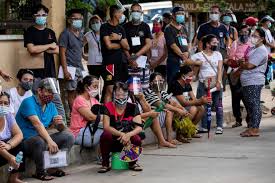The country’s unemployment rate climbed in July as millions of Filipinos who graduated from senior high school and college could not get jobs during the month, the Philippine Statistics Authority (PSA) said on Friday, September 6.
Data from the PSA’s Labor Force Survey showed that the unemployment rate in the Philippines surged to 4.7 percent in July from 3.1 percent in June.
This means that the number of unemployed Filipinos increased to 2.38 million in July 2024 from 1.62 million in June 2024.
In a press briefing, PSA Chief and National Statistician Dennis Mapa noted that the Filipinos aged 15 to 24 years old who are entering the labor market after graduating from K-12 or college faced difficulties finding jobs in July.
The National Statistician noted that youth unemployment made up 43 percent of the total unemployed individuals in July.
“Nakita namin [nitong] July kasi nag-graduate na ang nasa kolehiyo or K-12 at iba sa kanila ay ‘di nakahanap ng trabaho,” Mapa said.
Additionally, Mapa stated that various sectors – such as manufacturing and services – were impacted by weather disruptions, leading to reduced demand for workers.
The PSA adheres to the International Labor Organization’s criteria for defining an employed person, requiring them to work just one hour during the reference week.
However, Mapa highlighted that labor market activity usually picks up in the “-ber” months, with increased hiring during the holiday season.
“We are seeing, as we saw in the previous years, that we have an increase in employment, usually both labor force participation and employment when we have a holiday season. Particularly, it starts in September. I think it will bounce back,” Mapa said.
Asked about the potential impact of the ban on Philippine Offshore Gaming Operators (POGOs), Mapa explained that the gambling and betting sector, while a small part of the labor force, did not show a significant reduction in jobs.
In terms of regional performance, the Cordillera Administrative Region (CAR) recorded the highest employment rate at 97.7 percent, while the National Capital Region (NCR) had the lowest employment rate at 93.5 percent.
The unemployment rate was highest in NCR at 6.5 percent, while CAR posted the lowest at 2.3 percent.
Mapa noted that regions like Davao and Caraga saw improvements in employment rates, while areas such as the Ilocos Region and Calabarzon showed higher unemployment rates compared to the national average of 4.7 percent.
Employment rate
The total number of employed persons stood at 47.70 million in July 2024, an improvement of 3.14 million compared to the previous year.
However, this number was slightly lower than the 48.36 million recorded in April 2024. The employment rate was 95.3 percent, reflecting a modest increase from 95.1 percent in July 2023 but lower than April’s 96.0 percent.
Among the employed, the services sector remained dominant, accounting for 60.8 percent of the workforce, followed by the agriculture sector at 21.2 percent, and the industry sector at 18.0 percent.
Unemployment
The underemployment rate – the share of those already working but still looking for more work or longer working hours to the total employed population – stood at 12.1 percent in both June and July this year, meaning that there are 5.78 million Filipinos who are underemployed.
Year-on-year, the number of underemployed Filipinos declined by 1.29 million from July 2023.
In another statement, National Economic and Development Authority (NEDA) Secretary Arsenio Balisacan mentioned that the agency is in the process of completing the Trabaho Para sa Bayan Master Plan. This plan aims to serve as the country’s comprehensive strategy to improve job opportunities and enhance the skills of Filipino workers.
Balisacan also emphasized the importance of accelerating infrastructure projects in energy, logistics, and both physical and digital connectivity to address barriers to economic growth and business development.
“The swift enactment and implementation of the Konektadong Pinoy Bill, and the expansion of upskilling programs are crucial for advancing the country’s digital transformation and harnessing opportunities presented by cutting-edge innovation,” Balisacan said.
“The Marcos Administration is tirelessly working to attract high-quality investments to the country, enhancing the business climate and ensuring that all investment pledges are fulfilled. This, along with efforts to prepare the labor force for market absorption, gives us confidence that we will achieve our PDP targets,” he added. (TCSP)




